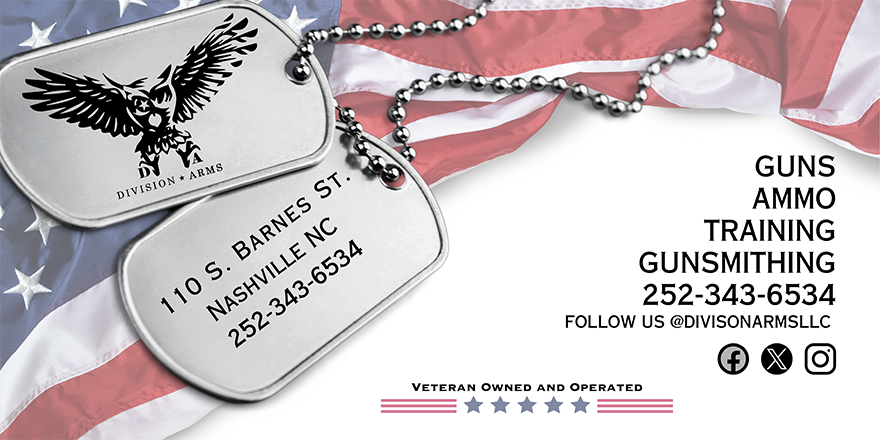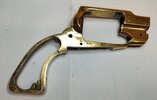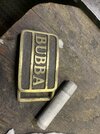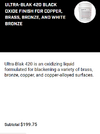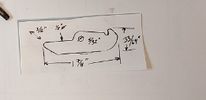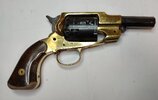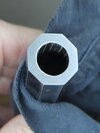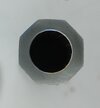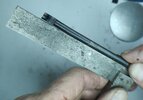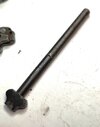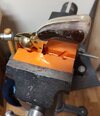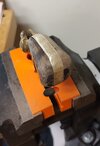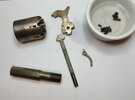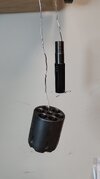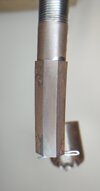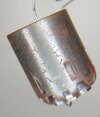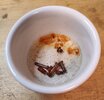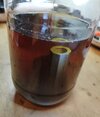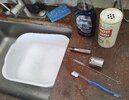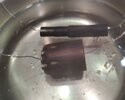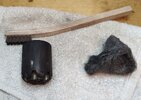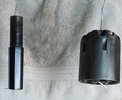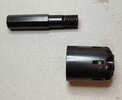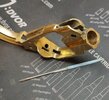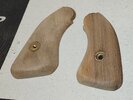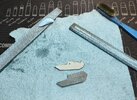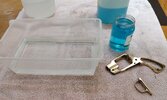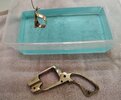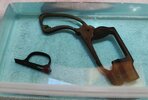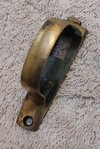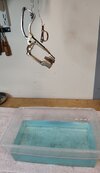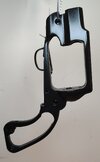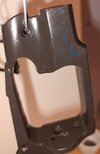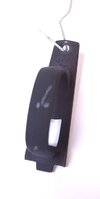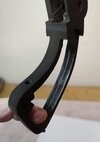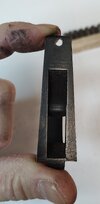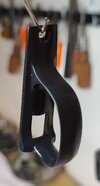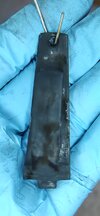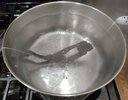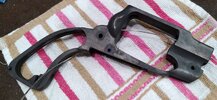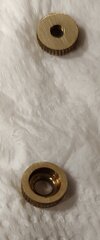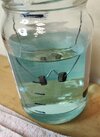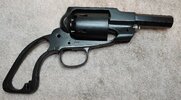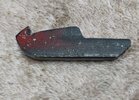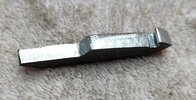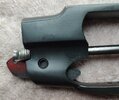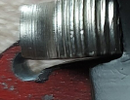I decided (a while ago) to make a BP Bulldog out of a brass-framed FIE 1858 Remington. Finally made some progress this evening.
I couldn't find the pics of it in its as-bought condition (used); the loading lever was probably not original & didn't function well - it bound up instead of traveling freely. It didn't appear bent, just poorly fitted. Test firing went ok.
It's been sitting around dismantled for quite a while as I tried to decide if it was worth ordering new parts for. It ain't! So here we go...
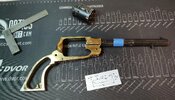
I decided to make it a 3-1/2" bbl. That would leave me plenty of room for a front sight of some kind, as well as give me some leeway for smoothing and squaring up the cut if my aptly named hack saw influenced my application of elbow grease.
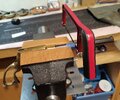
I cut a little rough on the side that my hand was blocked by the vise, but it wasn't too bad. It squared up easily enough. I'll work on the crown and perimeter edges later.
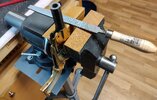
Side view to compare to original length. I'mstealing being inspired and influenced by a quick-release arbor pin holder that's available online now and again. I want to make it out of brass (which I've not seen offered) to match the frame, Current plan is to blacken the brass.
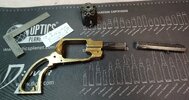
Then came the fun part. Holy Sulphurous Smoke! That sucker was HARD to break loose! I'd tried before (and made my tre' chic Homer Homeowner DIY frame wrench!), hit it with Kroil any number of times, then set it aside. Today, I cooked it but good with a butane chef's torch... 3 times... with more Kroil between each "firing." I had the Kroil bubbling up out of the threads while heating it, and it would ooze through the frame, but it still took so much force I felt sure I was gonna twist or snap the frame!
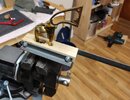
It finally came loose - and I didn't even bloody myself on the vise! Ah, sweet success.
Ah, sweet success.
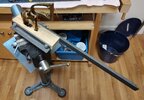
I cleaned the Mobil 1 off the innards (mostly). Here's where it stands after this evening's efforts.

It's hard to see on the white background, but I marked the corners of the grip frame with a white Sharpie to define the upcoming rounding of the grip; I will shape the walnut panels to match after I strip the finish off. I may make some new panels out of maple or faux ivory. The Bulldog will have a dark finish - I'll blacken the brass and re-blue the cylinder, barrel, arbor pin - so I think light colored grips would set it off nicely.
I'll bring the hammer & trigger back to white, then probably do a faux case hardening on 'em, depending on how the steel reacts to the chemicals. Ya never know what steel them 1960's & 70's Italians used for these "I Saw The Outlaw Josey Wales and Now I Want to Look Like a Cool Cowboy Renegade on the Cheap" models...
If I ever get back to it, I'll update this post!
I couldn't find the pics of it in its as-bought condition (used); the loading lever was probably not original & didn't function well - it bound up instead of traveling freely. It didn't appear bent, just poorly fitted. Test firing went ok.
It's been sitting around dismantled for quite a while as I tried to decide if it was worth ordering new parts for. It ain't! So here we go...

I decided to make it a 3-1/2" bbl. That would leave me plenty of room for a front sight of some kind, as well as give me some leeway for smoothing and squaring up the cut if my aptly named hack saw influenced my application of elbow grease.

I cut a little rough on the side that my hand was blocked by the vise, but it wasn't too bad. It squared up easily enough. I'll work on the crown and perimeter edges later.

Side view to compare to original length. I'm

Then came the fun part. Holy Sulphurous Smoke! That sucker was HARD to break loose! I'd tried before (and made my tre' chic Homer Homeowner DIY frame wrench!), hit it with Kroil any number of times, then set it aside. Today, I cooked it but good with a butane chef's torch... 3 times... with more Kroil between each "firing." I had the Kroil bubbling up out of the threads while heating it, and it would ooze through the frame, but it still took so much force I felt sure I was gonna twist or snap the frame!

It finally came loose - and I didn't even bloody myself on the vise!

I cleaned the Mobil 1 off the innards (mostly). Here's where it stands after this evening's efforts.

It's hard to see on the white background, but I marked the corners of the grip frame with a white Sharpie to define the upcoming rounding of the grip; I will shape the walnut panels to match after I strip the finish off. I may make some new panels out of maple or faux ivory. The Bulldog will have a dark finish - I'll blacken the brass and re-blue the cylinder, barrel, arbor pin - so I think light colored grips would set it off nicely.
I'll bring the hammer & trigger back to white, then probably do a faux case hardening on 'em, depending on how the steel reacts to the chemicals. Ya never know what steel them 1960's & 70's Italians used for these "I Saw The Outlaw Josey Wales and Now I Want to Look Like a Cool Cowboy Renegade on the Cheap" models...
If I ever get back to it, I'll update this post!

